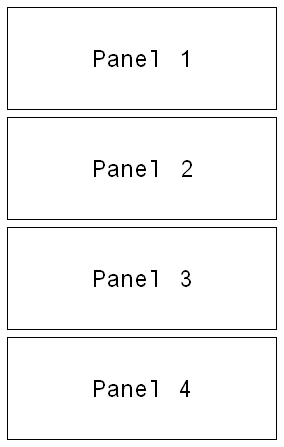4koma on:
[Wikipedia]
[Google]
[Amazon]
 , a
, a
 , a
, a comic strip
A comic strip is a sequence of drawings, often cartoons, arranged in interrelated panels to display brief humor or form a narrative, often serialized, with text in balloons and captions. Traditionally, throughout the 20th and into the 21st ...
format, generally consists of gag comic strips within four panels of equal size ordered from top to bottom. They also sometimes run right-to-left horizontally or use a hybrid 2×2 style, depending on the layout requirements of the publication in which they appear. Although the word ''yonkoma'' comes from Japanese
Japanese may refer to:
* Something from or related to Japan, an island country in East Asia
* Japanese language, spoken mainly in Japan
* Japanese people, the ethnic group that identifies with Japan through ancestry or culture
** Japanese diaspor ...
, the style also exists outside Japan in other Asia
Asia (, ) is one of the world's most notable geographical regions, which is either considered a continent in its own right or a subcontinent of Eurasia, which shares the continental landmass of Afro-Eurasia with Africa. Asia covers an area ...
n countries as well as in the English-speaking
Speakers of English are also known as Anglophones, and the countries where English is natively spoken by the majority of the population are termed the '' Anglosphere''. Over two billion people speak English , making English the largest langua ...
market, particularly in mid-20th century United States
The United States of America (U.S.A. or USA), commonly known as the United States (U.S. or US) or America, is a country primarily located in North America. It consists of 50 states, a federal district, five major unincorporated territorie ...
strips, where ''Peanuts
''Peanuts'' is a print syndication, syndicated daily strip, daily and Sunday strip, Sunday American comic strip written and illustrated by Charles M. Schulz. The strip's original run extended from 1950 to 2000, continuing in reruns afterward. ' ...
'' popularized the format.
Origin
Rakuten Kitazawa
, better known by the pen name , was a Japanese manga artist and ''nihonga'' artist. He drew many editorial cartoons and comic strips during the years from the late Meiji era through the early Shōwa era. He is considered by many historians to b ...
(who wrote under the name Yasuji Kitazawa) produced the first ''yonkoma'' in 1902. Entitled ''Jiji Manga'', it was thought to have been influenced by the works of Frank Arthur Nankivell
Frank Arthur Nankivell (1869–1959) was an Australian artist and political cartoonist, known for his caricatures in publications such as '' Puck''.
Early life
Nankivell was born to John and Annie Nankivell in Maldon, northwest of Castlem ...
and of Frederick Burr Opper.Carolin Fischer,'Mangaka',Unknown date of publication, "http://www.mangaka.co.uk/?page=yonkoma", 2009-10-29
Structure
Traditionally, ''yonkoma'' follow a structure known as ''kishōtenketsu
describes the structure and development of classic Chinese, Korean and Japanese narratives. The structure originated in China and was called ''qǐ chéng zhuǎn hé'' () and used in Chinese poetry as a four-line composition, such as Qijue. F ...
''. This word is a compound formed from the following Japanese kanji characters:
*''Ki'' (): The first panel forms the basis of the story; it sets the scene.
*''Shō'' (): The second panel develops upon the foundation of the story laid down in the first panel.
*''Ten'' (): The third panel is the climax, in which an unforeseen development occurs.
*''Ketsu'' (): The fourth panel is the conclusion, in which the effects of the third panel are seen.
Uses
These comic strips appear in almost all types of publications in Japan, includingmanga
Manga (Japanese: 漫画 ) are comics or graphic novels originating from Japan. Most manga conform to a style developed in Japan in the late 19th century, and the form has a long prehistory in earlier Japanese art. The term ''manga'' is u ...
magazines, graphic novel
A graphic novel is a long-form, fictional work of sequential art. The term ''graphic novel'' is often applied broadly, including fiction, non-fiction, and anthologized work, though this practice is highly contested by comic scholars and industry ...
s, the comics section of newspaper
A newspaper is a periodical publication containing written information about current events and is often typed in black ink with a white or gray background.
Newspapers can cover a wide variety of fields such as politics, business, sports a ...
s, game magazines, cooking magazines, and so forth. The plot often ends within the four panels; although some serial development may pass on to future installments, creating a more continuous story. Some ''yonkoma'' also tackle serious topics, though most do so with humor. Some manga occasionally use ''yonkoma'', usually at the end of a chapter or bound volume, as a non-canon joke to complement the story.
See also
* ''Jo-ha-kyū
is a concept of modulation and movement applied in a wide variety of traditional Japanese arts. Roughly translated to "beginning, break, rapid", it essentially means that all actions or efforts should begin slowly, speed up, and then end swiftl ...
'' – A type of three-act structure found in many traditional Japanese narrative forms
References
{{Comics 1902 introductions Anime and manga terminology